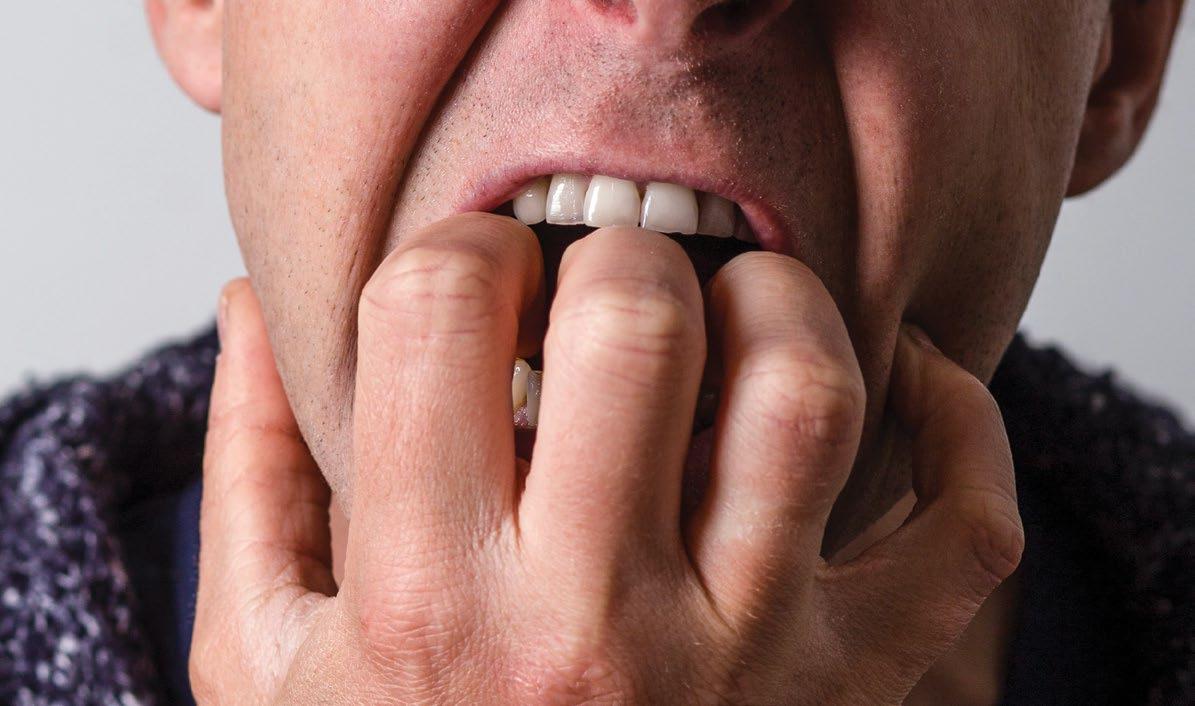
4 minute read
Clinical Feature
Clinical Feature Getting the Right Bite and the Bite Right
Dr Amanda Phoon Nguyen | Oral medicine specialist
Occlusal dysesthesia (OD), otherwise known as phantom bite syndrome or occlusal hypervigilance, is a condition where affected patients complain of bite discomfort without evident occlusal abnormalities. Originally described by Marbach in 1976 as a “monosymptomatic hypochondriacal syndrome”, and more recently known as a type of “somatic symptom disorder” as outlined in the criteria laid down in the 5th edition of the Diagnostic and Statistical Guide to Mental Disorders (DSM-5), OD may have overlapping features similar to those with body dysmorphic disorder (BDD). This is a condition in which tooth contacts that are not clinically identifiable as premature contacts nor associated with other disorders (eg of the periodontal tissues, the dental pulp, the masticatory muscles or the temporomandibular joints) have been perceived as disturbing or unpleasant, for six months or more. The clinical findings bear no recognisable relation to the type and strength of the complaints reported. Affected patients suffer from severe psychological and psychosocial stress, and they experience OD as a continuous impairment of their oral or physical wellbeing. They can be intensely preoccupied with their symptoms. Some studies have reported that they may be less capable of adapting to changes in their dentition, have higher levels of psychosomatic distress, and are often diagnosed with depression, anxiety disorders or somatic stress disorders related to other parts of the body. There is unknown prevalence or incidence of this condition, and it can present at any age, in any gender, with the condition often lasting decades. The exact aetiology is not sufficiently understood, however, it is perceived only in the waking state. Some literature has reported that some patients were experiencing an unusually stressful phase of their lives around the time of the first manifestation of the condition and that they had undergone dental treatment at the same time.
My Case Examples:
A middle-aged female was referred to me as she has had something stuck in-between her teeth for five years and cannot floss it out. She has seen multiple dentists, and no one can reach it. A middle-aged male was referred by an orthodontist as he would like a third round of fixed orthodontics to correct a “bad bite”, and the orthodontist suspected hallmarks of occlusal dysesthesia. A middle-aged female seen as she had many complaints about her multiple dentures and felt that the poor bite of her dentures were causing body asymmetry, with her clothes no longer fitting her well. She has also noted that her glasses would no longer “sit straight” on her nose as the dentures were changing the shape of her face. She was on her fourth set of dentures and was fixated on obtaining the next set of dentures which would fix her problems.
Marbach’s Diagnostic Indicators of PBS
PATIENT INDICATOR EXAMPLE
Believe that severe symptoms are all due to their occlusion
Perceived dental knowledge
Perception of a serious bite or cosmetic defect, with frustration that multiple clinicians cannot find the problem. There is a discrepancy between the clinical findings and the patient’s subjective sensation.
They often know dental jargon. They may talk about their ‘bite’ or ‘occlusal’ problems, ‘interferences’ and ‘shifts’, and suggest how they should be changed, or altered, to correct their problems. May be vehement.
Have study casts and detailed clinical records
Sustained delusion
Well-Presented
Difficulty accepting diagnosis or accepting referral to psychiatry
May come to the appointment with numerous diagnostic casts that they have accumulated over the years, or even an articulator. Patients may have many photos and have prepared detailed documents in an attempt to explain the problem.
While there may be some initial placebo effect, the symptoms are rarely improved by occlusal splint therapy, orthodontics, occlusal adjustments or “equilibration”, or prosthodontic interventions of different types by different dentists or various specialists. Patients may often report that multiple treatment providers have unsuccessfully tried to “adjust” their occlusion. Patients many have strong negative emotions regarding previous treatment providers, combined with excessive positive expectations of their new treatment provider. They may be very flattering.
May be seen more commonly in high socio-economic status patients (as they can afford to undergo repeated and extensive treatments to solve the problems), with above average intelligence, who are often very articulate about what needs to be done.
Resistant to the idea that their problem is psychiatric in origin and may refuse to be referred for this. Patients often tightly hold the belief that their problems were caused by previous dentists and if they could just find the "right" dentist to do the treatment they want (including orthodontics, prosthodontic treatment or even surgery), all their issues will be solved.
Management
Unfortunately, the acceptance of the occlusal dysesthesia diagnosis is low among patients. Patients with OD often stay attached to their somatic explanations. Management is difficult as patients usually remain resolutely convinced that if they could only get someone competent enough to get their “bite right” then all their problems would be solved. Defocusing is the main therapeutic objective. Multidisciplinary care is often required, and referral to a specialised clinic that considers concomitant psychological therapy should be offered. Patients may not respond well to the suggestion of psychiatric input, and if this is the case, discussion should be left to the specialist involved with the patient’s care. With care of OD patients, as with all somatic stress disorders, the prognosis is often poor, and management can be challenging. Expert-based consensus recommendations include patient counselling and education, psychological or psychiatric care, physical exercise, relaxation and psychotherapy, mindfulness training, and pharmacotherapy with medications such as chronic pain medications, tricyclic antidepressants, nor adrenergic and specific serotonergic antidepressants or atypical antipsychotic drugs. It is generally inadvisable to treat a suspected OD by adjusting the occlusion, as an occlusal adjustment may intensify the syndrome.
References available via amanda@pomds.com.au










